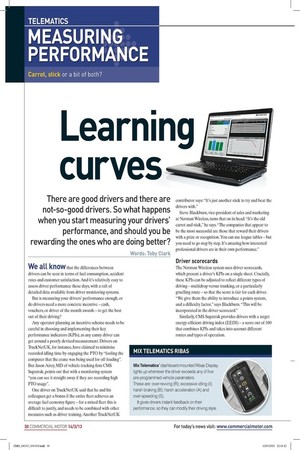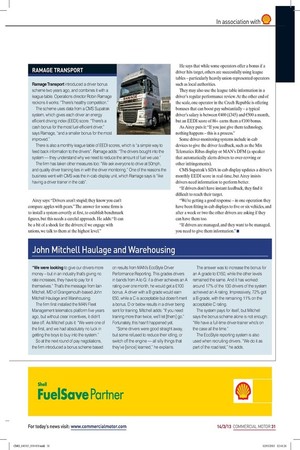Learning curves There are good drivers and there are not-so-good
Page 17

Page 18

If you've noticed an error in this article please click here to report it so we can fix it.
drivers. So what happens when you start measuring your drivers' performance, and should you be rewarding the ones who are doing better?
Words: Toby Clark We all know that the differences between drivers can be seen in terms of fuel consumption, accident rates and customer satisfaction. And it's relatively easy to assess driver performance these days, with a raft of detailed data available from driver monitoring systems.
But is measuring your drivers' performance enough, or do drivers need a more concrete incentive — cash, vouchers, or driver of the month awards — to get the best out of their driving?
Any operator planning an incentive scheme needs to be careful in choosing and implementing their key performance indicators (KPIs), as any canny driver can get around a poorly devised measurement. Drivers on TruckNetUK, for instance, have claimed to minimise recorded idling time by engaging the PTO by "fooling the computer that the crane was being used for off-loading". But Jason Airey, MD of vehicle tracking firm CMS Sup atrak, points out that with a monitoring system "you can see it straight away if they are recording high PTO usage".
One driver on TruckNetUK said that he and his colleagues get a bonus if the entire fleet achieves an average fuel economy figure — for a mixed fleet this is difficult to justify, and needs to be combined with other measures such as driver training. Another TruckNetUK contributor says: "It's just another stick to try and beat the drivers with."
Steve Blackburn, vice-president of sales and marketing at Navman Wireless, turns that on its head. "It's the old carrot and stick," he says. "The companies that appear to be the most successful are those that reward their drivers with a prize or recognition. You can use league tables — but you need to go step by step. It's amazing how interested professional drivers are in their own performance."
Driver scorecards The Navman Wireless system uses driver scorecards, which present a driver's KPIs on a single sheet. Crucially, these KPIs can be adjusted to reflect different types of driving — multidrop versus trunking, or a particularly gruelling route — so that the score is fair for each driver. "We give them the ability to introduce a points system, and a difficulty factor," says Blackburn. "This will be incorporated in the driver scorecard."
Similarly, CMS Supatrak provides drivers with a target energy-efficient driving index (EEDI) — a score out of 100 that combines KPIs and takes into account different routes and types of operation. Airey says: "Drivers aren't stupid; they know you can't compare apples with pears." The answer for some firms is to install a system covertly at first, to establish benchmark figures, but this needs a careful approach. He adds: "It can be a bit of a shock for the drivers; if we engage with unions, we talk to them at the highest level." He says that while some operators offer a bonus if a driver hits target, others are successfully using league tables – particularly heavily union-represented operators such as local authorities.
They may also use the league table information in a driver's regular performance review. At the other end of the scale, one operator in the Czech Republic is offering bonuses that can boost pay substantially – a typical driver's salary is between €400 (£345) and €500 a month, but an EEDI score of 86+ earns them a €100 bonus.
As Airey puts it: "If you just give them technology, nothing happens – this is a process."
Some driver-monitoring systems include in-cab devices to give the driver feedback, such as the Mix Telematics Ribas display or MAN's DFM (a speaker that automatically alerts drivers to over-revving or other infringements).
CMS Supatrak's SDA in-cab display updates a driver's monthly EEDI score in real-time, but Airey insists drivers need information to perform better.
"If drivers don't have instant feedback, they find it difficult to reach their target.
"We're getting a good response – in one operation they have been fitting in-cab displays to five or six vehicles, and after a week or two the other drivers are asking if they can have them too.
"If drivers are managed, and they want to be managed, you need to give them information." • RAMAGE TRANSPORT Ramage Transport introduced a driver bonus scheme two years ago, and combines it with a league table. Operations director Robin Ramage reckons it works: "There's healthy competition."
The scheme uses data from a CMS Supatrak system, which gives each driver an energy efficient driving index (EEDI) score. "There's a cash bonus for the most fuel-efficient driver," says Ramage, "and a smaller bonus for the most improved."
There is also a monthly league table of EEDI scores, which is "a simple way to feed back information to the drivers". Ramage adds: "The drivers bought into the system they understand why we need to reduce the amount of fuel we use."
The firm has taken other measures too: "We ask everyone to drive at 50mph, and quality driver training ties in with the driver monitoring." One of the reasons the business went with CMS was the in-cab display unit, which Ramage says is "like having a driver trainer in the cab".
John Mitchell Haulage and Warehousing "We were looking to give our drivers more money – but in an industry that's giving no rate increases, they have to pay for it themselves." That's the message from lain Mitchell, MD of Grangemouth-based John Mitchell Haulage and Warehousing.
The firm first installed the MAN Fleet Management telematics platform five years ago, but without clear incentives, it didn't take off. As Mitchell puts it: "We were one of the first, and we had absolutely no luck in getting the boys to buy into the system."
So at the next round of pay negotiations, the firm introduced a bonus scheme based on results from MAN's EcoStyle Driver Performance Reporting. This grades drivers in bands from A to G: if a driver achieves an A rating over one month, he would get a £100 bonus. A driver with a B grade would earn £50, while a C is acceptable but doesn't merit a bonus. D or below results in a driver being sent for training. Mitchell adds: "If you need training more than twice, we'll let [them] go." Fortunately, this hasn't happened yet.
"Some drivers were good straight away, but some refused to reduce their idling, or switch off the engine — all silly things that they've [since] learned," he explains. The answer was to increase the bonus for an A grade to £150, while the other levels remained the same. And it has worked: around 17% of the 130 drivers of the system achieved an A rating. Impressively, 72% got a B grade, with the remaining 11% on the acceptable C rating.
The system pays for itself, but Mitchell says the bonus scheme alone is not enough: "We have a full-time driver-trainer who's on the case all the time."
The EcoStyle reporting system is also used when recruiting drivers. "We do it as part of the road test," he adds.






































